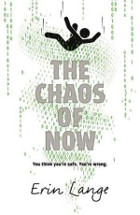The chaos of now by Erin Lange

Faber and Faber, 2018. ISBN: 9780571317479.
(Age: 13+) Highly recommended. Themes: Suicide, Bullying,
Cyberbullying, Schools, Power, Monitoring. A disturbing opening page
will ensure young adults read to the last page, so incensed at the
suicide that they will want to see the bullies brought to justice.
That Jordan was being bullied was not a secret, but his response
shocked the school into placing cybermonitors on the computing
system to stop such things happening again. Eli is amazed at this
response by the school; all done without consultation or getting to
the main problem. Lip service is given to making people aware,
having anti bullying signs around the school and a gratuitous
memorial service for Jordan after 12 months has elapsed. It makes
Eli sick, but he has problems of his own with his father bringing
home a woman to live in the house, and a nasty run in with one of
the school bullies, Malcolm.
A computer nerd, Eli is a coder, one of a small group of people for
whom the binary system is a language he can speak without fear, able
to hack into the school's computer system with ease, at one stage
hacking into the local police system, with disastrous consequences.
Two other geeks seek him out. They were friends of Jordan and had
planned to enter and win a computer hacking competition which would
bring them to the attention of corporations and the possibility of
work in an area they know well. With Jordan gone, Eli is their next
choice. But they are not just interested in winning a competition.
They want to heap revenge upon those students who bullied Jordan,
and they use their computer skills to achieve this.
This is an up to the minute look at the skills of the millenials,
able to use computers for their own ends, stretching the notions of
morality confining earlier users of technology, seeing possibilities
and uses beyond those proposed by their teachers. This is a most
unsettling look at the problem of cyber bullying, where the skills
of those perpetrators outstrip those of the monitors and Eli and his
friends represent those who are willing to use their skills to bring
down those who would bully. But have they turned into bullies
themselves? In posting some of the videos they illegally access
online, exposing one as a drug cheat, another as a racist another
dressing in his mother's clothes for a video, the question arises
about who is bullying who? Eli at first sees himself as exposing
wrong, but in doing this he becomes a vigilante, one who is outside
the law, taking the law into his own hands.
The line between right and wrong, black and white becomes very
blurred and makes for a read which will make people think about the
consequences of cyber bullying and how to deal with it. Readers will
want to know how Eli comes out of this, after all he and the others
have committed criminal acts.
Fran Knight